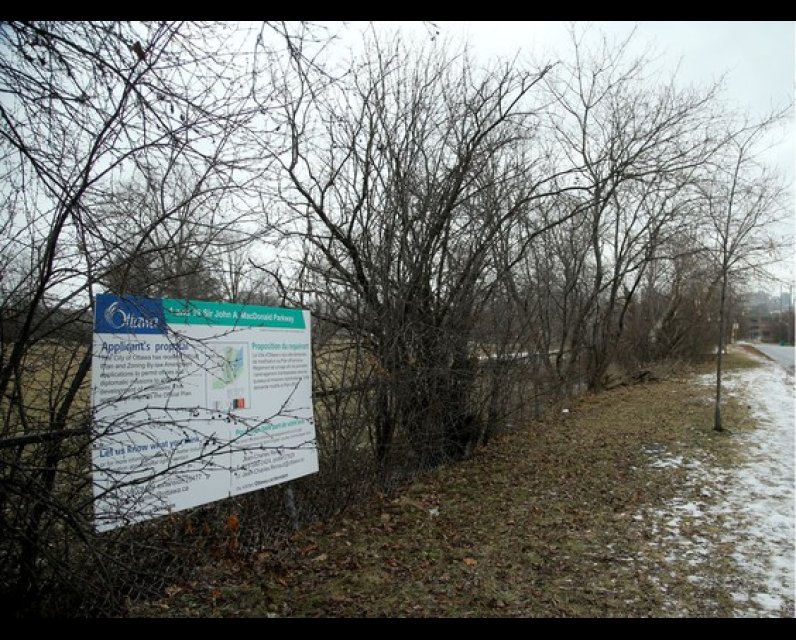Unpublished Opinions
Daniel Buckles is a resident of Kitchissippi Ward, and co-recipient of the 2020 Conservation Award from the Ottawa Field Naturalist Club for work to conserve Heritage Bur Oaks in the Champlain Park neighbourhood.
Buckles: An embassy row along the Ottawa River is a very bad idea

Having declared a 'Housing and Homelessness Emergency' almost exactly a year ago, the city should focus on social priorities instead of diplomatic bling.
The NCC submitted its plans to city hall in December, asking for approval to amend the zoning rules for the grassy 3.7-hectare field west of the Innovation Centre at Bayview Yards to accommodate six new embassies.
Ottawa is faced with a serious decision regarding housing for its urbanizing population. Having declared a “Housing and Homelessness Emergency” on Jan. 22, 2020, as a city we have continued to build mostly condos and single-family dwellings. Clearly these are the most profitable building forms, representing the traditional aspirations of relatively wealthy families and aging couples. They are also the easiest for builders, repeatable in virtually any location with architectural details added here and there to mimic art.
Meanwhile, we are presented time and again with opportunities to take a different path that meets head-on the times we live in and the moral and economic imperatives of housing for all. A proposed diplomatic precinct, reported on Dec. 26, 2020 in the Ottawa Citizen, is the most recent example.
The plan is bad for two reasons. First, it is tone-deaf to the desperate need for progressive and aggressive housing action in Ottawa. It was only in November, 2019 that the NCC and the city forced the eviction near the Bayview LRT station of 20 people made homeless months earlier by a rooming house fire. Meanwhile, plans to redevelop the federal government’s Tunney’s Pasture and city-owned industrial lands around Bayview Yards are barely crawling along. By contrast, approvals for new 31-story condo towers on private property along Parkdale, and near to the proposed Embassy Road, are quickly moving forward.
As Kitchissippi Ward Coun. Jeff Leiper noted in a recent newsletter, “While the City and NCC’s plans have for several years anticipated the kind of development now being proposed, we have an opportunity to take a pause and consider whether this is the right use for this valuable parcel so close to the best transportation infrastructure in the city.”
Second, the land is an important fragment of the Ottawa River’s ecological services offered to people free and potentially in perpetuity by nature. Local residents have documented approximately 130 trees on the property, including several large, healthy middle-aged examples of Red Oak and Tamarack. Some 63 bird species have been documented there, a sign of why the NCC partnered with Birds International to declare the broader riverside lands an internationally significant bird migratory route. Last spring, the NCC roped off part of the area to keep people from harassing a rare nesting owl. A Peregrine Falcon nesting in one of Tunney’s towers also frequents the site.
The lands are also the most proximate buffer against shoreline flooding for the LaRoche neighbourhood in Mechanicsville and the city’s own significant investment in the Bayview Yards Innovation Centre. If the amendment to the existing Official Plan is approved, it will happen before proposed rules against building on flood plains come into force under the new Official Plan. Disturbing the heavy metals, volatile organic compounds and polycyclic aromatic hydrocarbons known to have settled into the earth on the property is equally unwise given its proximity to the Lemieux Water Treatment Plant. By contrast, enhancing the capacity of the buffer to support biodiversity and sequester carbon in healthy grasslands and open forest would be a low-cost, nature-based solution compatible with recreational uses. This is what the public lands along the Ottawa River were set aside for in the first place.
The city’s response to the NCC application should be swift and precise, much like the elite predator birds that would be protected. There is simply no need for another Embassy Row on prime public land currently serving Canadians and visitors with nature in the city. It would amount to a form of elite embassy bling, ostentatious and superfluous to the felt needs of Canadians. Instead, the focus for federal and municipal authorities should be on accelerating plans to develop the current concrete desert at Tunney’s Pasture and Bayview Yards. There, new buildings can be mixed and integrated into the neighbourhood to meet a wide range of housing and business needs for decades to come.
Daniel Buckles is a resident of Kitchissippi Ward. is the co-recipient of the 2020 Conservation Award from the Ottawa Field Naturalist Club for work to conserve Heritage Bur Oaks in Champlain Park neighbourhood.



Comments
Be the first to comment